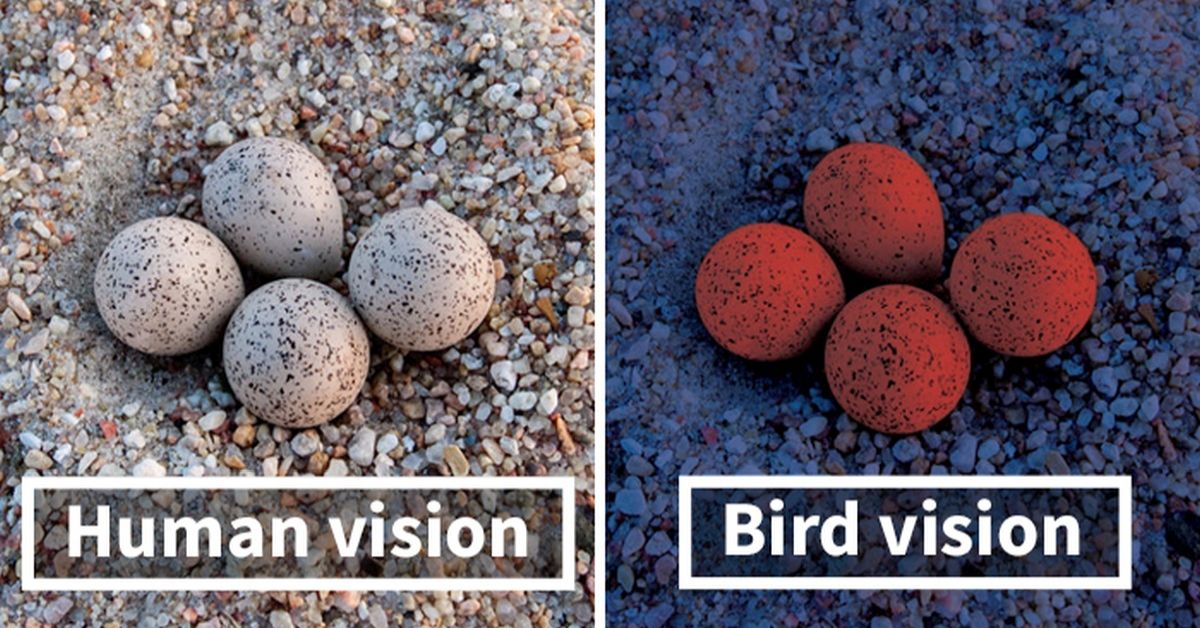Hummingbirds can perceive colours that the human eye cannot, thanks to the addition of an extra cone in their eyes that we humans don’t have.

Birds rely on their excellent color vision in many ways, from finding food and dazzling mates, through escaping predators, to navigating diverse terrain.
“Humans are color-blind compared to birds and many other animals,” said Mary Caswell Stoddard, an assistant professor at the Princeton University Department of Ecology and Evolutionary Biology.
Unlike humans, who have three kinds of colour-sensitive cone cells in our eyes, birds have four types of cone cells that help them to process the differences between different kinds of colours. With three cones, human eyes can perceive what’s known as trichromatic colour, made up from a neural blend of red, green, and blue light. Birds, however, have a fourth type, which is sensitive to ultraviolet light. “Not only does having a fourth color cone type extend the range of bird-visible colors into the UV, it potentially allows birds to perceive combination colors like ultraviolet+green and ultraviolet+red – but this has been hard to test,” said Stoddard.
With that extra cone, birds can see an even great spectrum of colours by being sensitive to more kinds of light wavelengths – opening the door to kinds of colour combinations that we humans can’t see or even imagine.
To find out how birds perceive their colorful world, Stoddard and her research team established a new field system for exploring bird color vision in a natural setting. The scientists trained wild broad-tailed hummingbirds (Selasphorus platycercus) to participate in color vision experiments conducted at the Rocky Mountain Biological Laboratory (RMBL) in Gothic, Colorado.

Photo by David Inouye, University of Maryland-College Park
The findings, demonstrated in experiments with wild broad-tailed hummingbirds (Selasphorus platycercus) in Colorado, suggest that the ability to discriminate non-spectral colours (including ultraviolet wavelengths) could play a vital role in behaviours including mating, feeding, and evading predators.
Stoddard’s team was particularly interested in “nonspectral” color combinations, which involve hues from widely separated parts of the color spectrum, as opposed to blends of neighboring colors like teal (blue-green) or yellow (green-red). For humans, purple is the clearest example of a nonspectral color. Technically, purple is not in the rainbow: it arises when our blue (short-wave) and red (long-wave) cones are stimulated, but not green (medium-wave) cones.
The researchers designed a set of experiments to see if hummingbirds can see these nonspectral colors. They started out by building a pair of custom “bird vision” LED tubes programmed to display a broad range of colors, including nonspectral colors like ultraviolet+green. Then, they performed experiments in an alpine meadow frequented by broad-tailed hummingbirds breeding at the high-altitude site.

The team placed the LED tubes beside water-feeders, some of which contained sugar water (which the birds like) next to one colour, while others contained plain water next to a different colour. They would then swap the positions of the feeders to see if the hummingbirds could use the colour indicator to tell which feeder was which. In a matter of several hours, wild hummingbirds learned to visit the rewarding color. Using the same setup, the researchers recorded over 6,000 feeder visits in a series of 19 experiments.
According to the results, hummingbirds can see a variety of nonspectral colors, including purple, ultraviolet+green, ultraviolet+red and ultraviolet+yellow. For instance, in the course of this experiment hummingbirds readily distinguished ultraviolet+green from pure ultraviolet or pure green, and they also discriminated between two different mixtures of ultraviolet+red light — one redder, one less so.
Appreciating how these colors actually appear to birds can be a difficult difficult task though. “It is impossible to really know how the birds perceive these colors. Is ultraviolet+red a mix of those colors, or an entirely new color? We can only speculate,” said Ben Hogan, a postdoctoral research associate at Princeton and a co-author of the study.
In a post on human vision vs bird vision published on The Mission earlier, we did publish some interesting renderings of how birds might see the world, according to research. Here are two examples:


Apparently, “bird’s exe view” is much more fascinating then human vision, but apparently we don’t need it, at least according to evolution.
